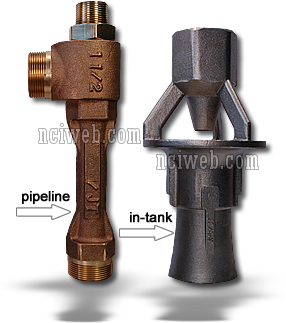 Jet Pumps and Tank Eductors
Jet Pumps and Tank Eductors
We invite you to explore the possibilities of jet pumps and tank eductors use in your operation. You might be surprised at the many ways jet pumps can help improve your company’s profitability!
Providing a practical alternative to more complicated and expensive methods, jet pumps offer simple, more cost-effective ways to pump, mix or heat a wide range of liquids and gases used in the process industry. Jet pumps can operate with a wide variety of motive liquids and gases.
Jet pumps have a myriad of uses. Jet pumps not only pump liquids, they can also heat, mix and blend either in-line or in-tank. Jet pumps can evacuate gases, create a vacuum, boost suction pressures, mix granular solids with liquids and move granular solids with compressed air. In fact, you will be surprised at what a jet pump can do to solve your problem.
While jet pumps and eductors may differ in appearance, basic operation is the same. Jet pumps, also known as eductors, operate on the principles of fluid dynamics. An operating fluid media, which is referred to as the MOTIVE, placed under pressure enters the inlet and is forced through the nozzle where it is converted into a high-velocity stream. This high-velocity stream decreases the pressure in the suction chamber, creating a partial vacuum that draws the suction material into the chamber where it is entrained by the motive media. Once the SUCTION stream is drawn in, shear between motive media and the transported material causes both media to be intermixed and pumped out the DISCHARGE outlet, dispelled at a pressure greater than that of the SUCTION stream but lower than that of the MOTIVE. This basic principle of fluid dynamics is what makes jet pumps work.
